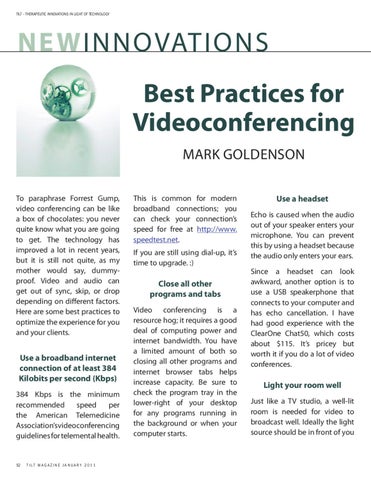TILT – Therapeutic Innovations in Light of Technology
Ne wInnovations Best Practices for Videoconferencing Mark Goldenson To paraphrase Forrest Gump, video conferencing can be like a box of chocolates: you never quite know what you are going to get. The technology has improved a lot in recent years, but it is still not quite, as my mother would say, dummyproof. Video and audio can get out of sync, skip, or drop depending on different factors. Here are some best practices to optimize the experience for you and your clients.
Use a broadband internet connection of at least 384 Kilobits per second (Kbps) 384 Kbps is the minimum recommended speed per the American Telemedicine Association’s video conferencing guidelines for telemental health.
52
T I L T MAGAZ I N E J a n u a r y 2 0 1 1
This is common for modern broadband connections; you can check your connection’s speed for free at http://www. speedtest.net. If you are still using dial-up, it’s time to upgrade. :)
Close all other programs and tabs Video conferencing is a resource hog; it requires a good deal of computing power and internet bandwidth. You have a limited amount of both so closing all other programs and internet browser tabs helps increase capacity. Be sure to check the program tray in the lower-right of your desktop for any programs running in the background or when your computer starts.
Use a headset Echo is caused when the audio out of your speaker enters your microphone. You can prevent this by using a headset because the audio only enters your ears. Since a headset can look awkward, another option is to use a USB speakerphone that connects to your computer and has echo cancellation. I have had good experience with the ClearOne Chat50, which costs about $115. It’s pricey but worth it if you do a lot of video conferences.
Light your room well Just like a TV studio, a well-lit room is needed for video to broadcast well. Ideally the light source should be in front of you
